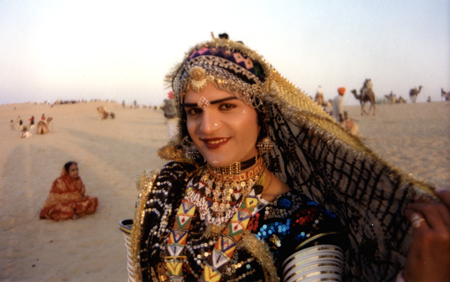|
|
|
|
Written, Produced & Directed by: Jasmine Dellal.
Photographed by: Albert Maysles & Alain De Halleux.
Edited by: Mary Myers & Dellal with Roko Belic & Angelo Corrao.
Released by: Shadow Distribution.
Language: English, Romani, Spanish, Romanian, Macedonian, Hindi & Marwari with English subtitles.
Country of Origin: USA/UK/The Netherlands. 111 min. Not Rated.
Featuring: Antonio El Pipa Flamenco Ensemble, Fanfare Ciocarlia, Maharaja, Esma Redzepova & Ensemble Teodosievski & Taraf de Haïdouks.
Gypsy Caravan charms the eyes and ears as director Jasmine Dellal and noted cameramen Albert Maysles and Alain De Halleux accompany 35 performers in five troupes speaking nine languages from four countries on a six-week North American tour, and later back home.
Proudly celebrating the diversity and commonalities of the Romani culture (the negative-laden term, Gypsy, mistakes their origin as Egyptian), the film intertwines three perspectives – colorful music and dance concert footage, a lot of off-stage informalities, and portraits of the key performers in relation to their large extended families, schools, and whole villages they support.
Flamenco is the most recognized Gypsy export to world culture and the World Music Institute produces the noted annual New York Flamenco Festival as well as this tour and the accompanying soundtrack album. Like the traditionalists in Carlos Saura’s film Flamenco, the Antonio El Pipa Flamenco Ensemble of Andalucía emphasizes the interactive improvisation among the family members’ mournful singing, feet stomping, hand clapping, and guitar playing.
Less obvious to gadjos (non-Gypsies) is the inclusion of the Maharaja ensemble from India. By embodying thousands-year-old traditions, they connect to Gypsies’ true ancestral origins (the Roma language derives from Sanskrit). A stunning performer, Harish twirls dervish-like on his knees in elaborate make-up and costumes. But he’s also a vivacious cultural facilitator, not only convincing local Indian restaurants that, yes, he does want it spicier, but also inspiring collaboration between the groups. (He cannily mimics each of the other performers’ styles.) At home in Rajasthan, he brings together musicians and dancers from many different castes into his troupe. The camels casually strolling by his front door are more interesting than the extended footage of stray dogs in the other hometowns.
Back in Macedonia, “Queen of the Gypsies” Esma Redzepova helps Roma refugees from Kosovo and recounts how her wounded father was the sole survivor of a Nazi massacre of Gypsies and Jews in Skopje. The repertoire for the 11-man brass band Fanfare Ciocarlia includes horas and rumbas played on multiple tubas and trumpets in an irresistibly lively style linking Turkish and klezmer traditions. And patriarch Nicolae Neascu’s remarkable string bowing is the centerpiece of the band Taraf de Haïdouks. In an interview, admiring fan Johnny Depp provides the usual mainstream celebrity endorsement, based on having starred as a Gypsy along side the band in Sally Potter’s The Man Who Cried.
The back and forth editing between the performers on stage and then at home sharing traditions with the next generation compensates for the uneven
wandering throughout. Though sometimes the lyrics are translated and the gist of the songs described, there’s little discussion of the genres or
styles (the tour clips are mostly either party songs for dancing or table songs for crying), and all the performers are only identified at the end.
Particularly lacking are explanations of the intriguing instruments, such as Taraf de Haïdouks’ cimbalom dulcimer or Maharaja’s bowed saarangi.
Fatih Akin’s Crossing the Bridge: The Sound of Istanbul also usefully explores the influences on and impact of Gypsies’ music as they
traveled from India through the Bosporus Strait.
Nora Lee Mandel
June 15, 2007


